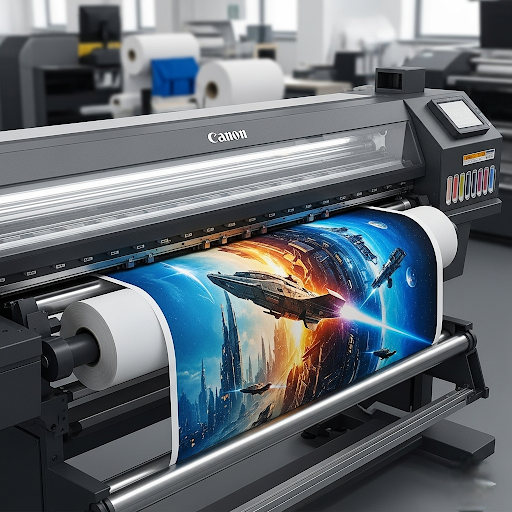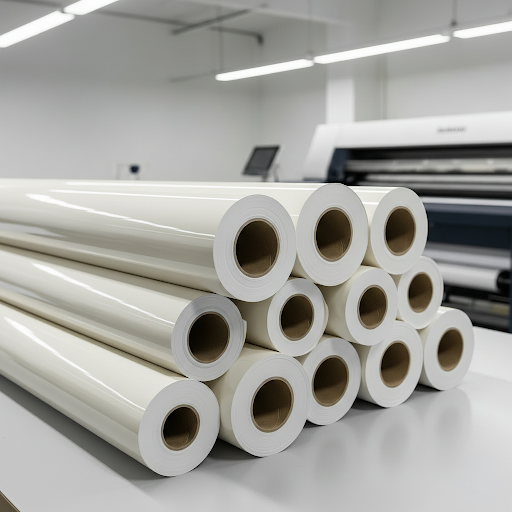
DISCOUNTED EDUCATION PRICING! CALL 1-877-891-8411. We Gladly Accept School Purchase Orders!

If you’ve ever invested in a wide format printer, you know the excitement of being able to produce big, bold, eye-catching visuals. But here’s the truth: your final print is only as good as the poster paper you feed into that machine.
The wrong paper turns crisp designs into blurry messes. The right paper? It makes colors pop, text sharp, and posters durable enough to last all school year.
This guide is the most complete resource on poster paper for wide format printers—built for schools, educators, and organizations who want to maximize quality without overspending. We’ll cover types, weights, coatings, costs, durability, eco-friendliness, and practical tips for choosing the right paper every time.
Most people obsess over the printer: brand, ink type, speed. But the real star behind every vibrant classroom poster or sharp event banner is the poster paper itself.
Think of your poster printer as the artist’s brush—and poster paper as the canvas. A great brush is useless if the canvas can’t hold the paint.
Schools, businesses, and nonprofit organizations frequently find themselves navigating a complex landscape of choices when selecting Poster Printer Supplies, often feeling overwhelmed by the sheer variety of available options. To simplify this decision-making process, here’s a comprehensive breakdown of the most common types of materials or solutions, highlighting their unique strengths and the specific scenarios or applications where they excel most effectively:
👉 For schools, self-adhesive poster paper is a game-changer—teachers can slap posters onto walls without needing tape, staples, or mounting boards.
Paper “weight” determines how sturdy and professional your poster feels. Here’s a quick breakdown:
| Paper Weight | Common Uses | Durability | Best For |
|---|---|---|---|
| 24–28 lb bond | Quick announcements, temporary displays | Low | Daily class posters |
| 32–36 lb bond | School hallways, project-based learning | Medium | Multi-week displays |
| 42–46 lb bond | Year-long classroom decor, event backdrops | High | Durable posters without lamination |
💡 Pro Tip: For schools, 36 lb coated matte poster paper is the “sweet spot”—affordable, durable, and vibrant.
Poster paper isn’t just about decoration—it’s a learning tool.
📊 Study Spotlight: The Journal of Educational Psychology reports that students retain up to 65% more information when visuals supplement text-based learning. Poster paper isn’t just a supply—it’s a brain booster.
Schools often ask: Is wide format poster paper really affordable?
Here’s the breakdown:
But the smarter way to compare is cost per poster.
| Roll Size | Avg. Roll Cost | Posters per Roll | Cost per Poster |
|---|---|---|---|
| 24” x 150 ft | $90 | ~50 posters | $1.80 each |
| 24” x 300 ft | $160 | ~100 posters | $1.60 each |
✅ Outsourcing a 24” x 36” poster can cost $25–$40 each. Printing in-house on poster paper costs under $2 each.
That’s a savings of over 90%—enough to justify the printer investment within months.
Schools often debate: Should we laminate posters or just print on heavier stock?
👉 Rule of Thumb: If you need a poster for years, laminate. If it’s one semester or event-based, go with heavyweight poster paper.
Today’s schools are increasingly eco-conscious. Thankfully, wide format poster paper has evolved:
✅ Pro Tip: Ask your supplier if their poster paper is 100% recyclable—many are, which means teachers can simply place old posters in the blue bin.
Q1. Can I use regular copier paper in my wide format printer?
Technically yes, but it’s a disaster—colors bleed, edges curl, and the printer often jams. Always use media designed for wide format inkjet.
Q2. Do all wide format printers take the same poster paper?
No. Check:
Q3. What’s better for classrooms—matte or glossy poster paper?
Matte paper is better for readability under bright lights. Glossy is best for art projects and photo-based visuals.
Q4. How should I store poster paper rolls?
Q5. What’s the cheapest way for schools to use poster paper?
Buy in bulk rolls (2–4 at a time). This drops cost per poster by 15–25%.
We asked a few school print room managers for their advice:
Good quality poster paper isn’t just a supply—it’s the backbone of wide format printing. For schools, it’s what transforms blank walls into learning environments, boosts student engagement, and saves money year after year.
When choosing poster paper, consider:
Investing in high-quality poster printer paper is a critical decision for anyone seeking to produce professional-grade wide format prints that leave a lasting impression. The right choice of paper ensures that your prints not only showcase vibrant colors and sharp details but also maintain their visual appeal and structural integrity over an extended period. By prioritizing premium materials, you enhance the overall impact of your posters, whether they’re used for marketing, events, or artistic displays, ensuring they captivate audiences and withstand environmental factors. This strategic investment in superior poster paper ultimately delivers maximum value, elevating the quality of your prints and reinforcing their professional appearance for long-term success.